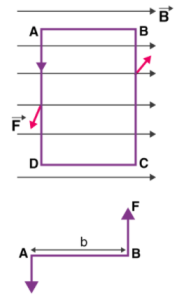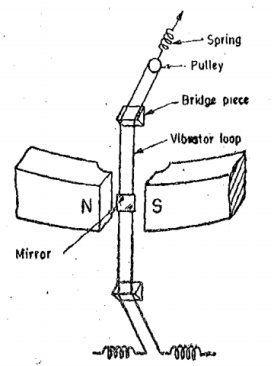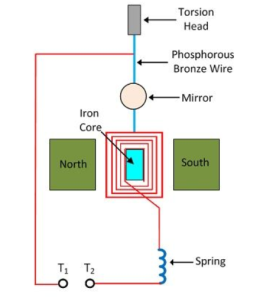|
|
A = l × b When current flows across the coil, then the torque is developed . The magnitude of the torque is given by τ = NiBA Assume that the flow of current across the coil for each minimal time is dt and so the change in current is represented as τ dt = NiBA dt When there is current flow across the coil for a time of ‘t’ seconds, then the value is represented as ʃ0t τ dt = NBA ʃ0t idt = NBAq where ‘q’ is the total amount of charge that flows across the coil. The inertial moment that exists for the coil is shown as ‘I’ and the coil’s angular velocity is shown as ‘ω’. The below expression provides the angular momentum of the coil and it is lω. It is like the pressure that is applied to the coil. By multiplying the above two equations, we get lw = NBAq Also, the kinetic energy across the coil will have deflection at ‘ϴ’ angle and the deflection will be restored using the spring. It is represented by Restoring torque value = (1/2)cϴ2 Kinetic energy value = (1/2)lw2 As the coil’s restoring torque is similar to the deflection then (1/2)cϴ2 = (1/2)lw2 cϴ2 = lw2 Also, the periodic oscillations of the coil is shown as below T = 2π√(l/c) T2 = (4π2l/c) (T2/4π2) = (l/c) (cT2/4π2) = l Finally, (ctϴ/2π) =lw = NBAq q = (ctϴ)/NBA2π q = [(ct)/NBA2π] * ϴ) Assume that k = [(ct)/NBA2π Then q = k ϴ So, ‘k’ is the constant term of the ballistic galvanometer. |
|
 is the angle turned through by the mirror then d = 2 r
is the angle turned through by the mirror then d = 2 r  = d/2r = 44 x 10 -8 / 2 x0.4 = 55 x 10 -3 rad Q7) The coil of moving coil galvanometer is wound on non-magnetic former whose height and width are both 2cm. It moves in constant field of 0.12 Wb/m2. The moment of inertia of its moving parts 0.25x 10 -5 kg-m2 and the control spring constant is 30 x 10 -6 Nm/rad. Calculate the number of turns that must be wound on the coil to produce a deflection of 150 o with current of 10mA.
= d/2r = 44 x 10 -8 / 2 x0.4 = 55 x 10 -3 rad Q7) The coil of moving coil galvanometer is wound on non-magnetic former whose height and width are both 2cm. It moves in constant field of 0.12 Wb/m2. The moment of inertia of its moving parts 0.25x 10 -5 kg-m2 and the control spring constant is 30 x 10 -6 Nm/rad. Calculate the number of turns that must be wound on the coil to produce a deflection of 150 o with current of 10mA. Final steady deflection Current i=10mA Constant spring constant K = 30 x 10 -6 Nm/rad Final steady deflection Displacement constant G = K But displacement constant G = NBld Number of turns N = G/BlD = 2.5 π x 10 -3 / 0.12 x 0.02 x 0.02 = 164 |
Total damping factor in the absence of all other damping except the damping produced by former is D = G2 / N2 Rt = N2 B2 I 2 d2 / N2 Rt For critical damping B2 I 2 d2 / Rt = 2 √ K J Hence resistance of former Rt = B2 I 2 d2 / 2 √ K J = (0.15) 2 x (30 x 10-3) 2 x (20 x 10-3) 2 / 2 √ 18 x 10 -6 x 80 x 10 -9 = 3375 |
The resistance of the galvanometer circuit = 20 + 150 = 170 Ω Galvanometer constant Kv= 10 μC/div Now Kq = Q/ But changes in flux linkages ∆ e = 2 Hnece Kq = 2 BAN/t . t/ R Flux density B = KqR Ballastic sensitivity Sv= 1/Kq = 1/110 = 9.1 x 10 -3 div/μC = 9100 div/C Flux linkage sensitivity = Sɸ = Sq/R = 9100/150 = 60 weber turn/div |
Let us assume that angular deflection of 60 o is the deflection of the reflected ray from the mirror attached to the moving coil Charge Q = Kq Kq = 1000/ π/3 = 3000/π μ C/rad Angle turned through the reflected ray for a swing of 10mm is Charge for a swing of 0.01 radian is Q = 3000/π x 0.01 = 9.56 μ C |

















